Learning few things about Spain before your trip, will give you greater appreciation for Spain’s history food, culture, language and people. It will make you enjoy sounds and sights of this amazing country. Most importantly, it make it easy to connect with locals and make new friends for life, and that what travel is all about. So pour yourself glass of Rioja wine, put on some Flamenco music and read on!
SPAIN: History, Food, Culture and Language
The familiar images of Spain – flamenco dancing, bullfighting, tapas bars and solemn Easter processions – do no more than hint at the diversity of the country. Spain has four official languages, two major cities of almost equal importance and a greater range of landscapes than any other European country. These remarkable contrasts make Spain an endlessly fascinating country to visit.
Consequently, after touring Portugal it was time for our adventure in Spain to begin and for us to explore great cities of Salamanca, Toledo, Cordoba, Seville, Granada and Barcelona. Join me in next series of articles and enjoy Spain with us!
PORTRAIT OF SPAIN
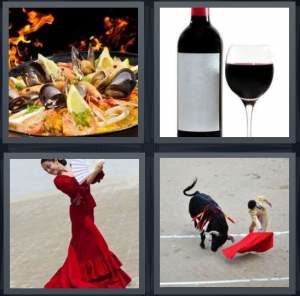
Portrait-of-Spain
Separated from the rest of Europe by the Pyrenees, Spain reaches south to the coast of North Africa. It has both Atlantic and Mediterranean coastlines, and includes two archipelagos – the Balearics and the Canary Islands. The climate and landscape vary from snow capped peaks in the Pyrenees, through the green meadows of Galicia and the orange groves of Valencia, to the desert of Almería. Madrid is the highest capital in Europe, and Spain its most mountainous country after Switzerland and Austria. The innumerable sierras have always hindered communications. Until railways were built it was easier to move goods from Barcelona to South America than to Madrid. In early times, Spain was a coveted prize for foreign conquerors, including the Phoenicians and the Romans. During the Middle Ages, much of it was ruled by the Moors, who arrived from North Africa in the 8th century. It was reconquered by Christian forces, and unified at the end of the 15th century. A succession of rulers tried to impose a common culture, but Spain remains as culturally diverse as ever. Several regions have maintained a strong sense of their own independent identities. Many Basques and Catalans, in particular, do not consider themselves to be Spanish. Madrid may be the nominal capital, but it is closely rivalled in commerce, the arts and sport by Barcelona, the capital city of Catalonia
HISTORY OF SPAIN
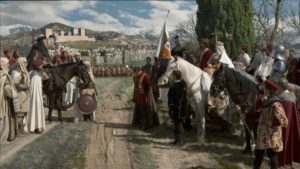
Surrender-of-Granada-History-of-Spain
Iberian Peninsula, first inhabited around 800,000 BC, has long been subject to foreign influences. From the 11th century BC it was colonized by sophisticated eastern Mediterranean civilizations, starting with the Phoenicians, then the Greeks and Carthaginians.
Romans
Romans arrived in 218 BC to fight the Carthaginians, thus sparking off the Second Punic War. They harvested the peninsula’s agricultural and mineral wealth and established cities with aqueducts, temples and theatres. With the fall of the Roman Empire in the early 5th century AD, Visigoth invaders from the north assumed power. Their poor political organization, however, made them easy prey to the Moors from North Africa. In the 8th century, the peninsula came almost entirely under Moorish rule. Europe’s only major Muslim territory, the civilization of Al Andalus excelled in mathematics, geography, astronomy and poetry. In the 9th and 10th centuries Córdoba was Europe’s leading city.
Catholic Monarchs
From the 11th century, northern Christian kingdoms initiated a military reconquest of Al Andalus. The marriage, in 1469, of Fernando of Aragón and Isabel of Castile, the so-called Catholic Monarchs, led to Spanish unity. They took Granada, the last Moorish kingdom, in 1492. Columbus discovered the Americas in the same year, opening the way for the Spanish conquistadors, who plundered the civilizations of the New World. The succeeding Habsburg dynasty spent the riches from the New World in endless foreign wars. Spain’s decline was exacerbated by high inflation and religious oppression.
Spanish Civil War
Although the Enlightenment in the late 18th century created a climate of learning, Spain’s misfortunes continued into the next century with an invasion by Napoleon’s troops and the loss of her American colonies. A new radicalism began to emerge, creating a strong Anarchist movement. The political instability of the late 19th and early 20th centuries led to dictatorship in the 1920s and a republic in the 1930s, which was destroyed by the Spanish Civil War. Victorious General Franco ruled by repression until his death in 1975. Since then Spain has been a constitutional monarchy.
SPAIN THROUGH THE YEAR
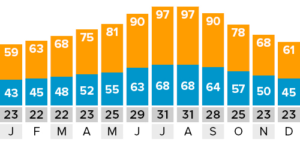
Weather-Spain-Madrid
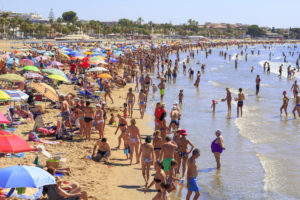
crowded-beach-Summer-Spain
Festivals, cultural events and sports competitions crowd the calendar in Spain. Even small villages have at least one traditional fiesta, lasting a week or more, when parades, bull fights and fireworks displays replace work. Many rural and coastal towns celebrate the harvest or fishing catch with a gastronomic fair at which you can sample local produce. Music, dance, drama and film festivals are held in Spain’s major cities throughout the year. Meanwhile, the country’s favorite outdoor sports – Football (real name for Soccer as it is played with feet, not hands!), basketball, cycling, sailing, golf and tennis – culminate in several national and international championships. It is a good idea to confirm specific dates of events with the local tourist board as some vary from year to year. My favorite time in Spain is Spring, however, Spain is great place to visit throughout the year. Keep in mind that Southern Spain can be scorching hot and crowded during Summer school break from July till August.
The Fiestas of Spain
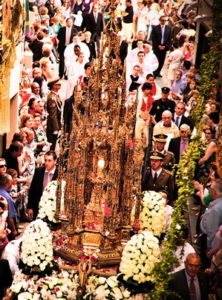
Fiesta-Spain
On any day of the year there is a fiesta happening somewhere in Spain – usually more than one. There isn’t a village, town or city in the country which doesn’t honor its patron saint, the Virgin or the changing seasons with processions, bull running, fire works, re-enacted battles, some ancestral rite or a romería – a mass pilgrimage to a rural shrine. Whatever the pretext, a fiesta is a chance for everyone to take a break from normal life (most shops and offices close) and let off steam, with celebrations sometimes going on around the clock. My favorite is Seville’s Spring Fair, the Feria.
Dinning and Food

Spanish-food
Spanish tend to eat late. Lunch takes place around 2 or 3 in the afternoon, and dinner can come as late as 9 or 10 at night. Lunch ranks as the primary meal of the day, featuring multiple courses and a longer time frame. Spaniards are also known for skipping out on household dinners in favor of eating out at a tapas bar instead. Tapas consists of pieces of bread with toppings such as meats, olives and cheese.
Traditional Spanish Food
If you’ve ever wondered what typical Spanish food is like, wonder no more! I’ve compiled a list of some of the most typical Spanish dishes to help guide you on your culinary exploration!
Paella
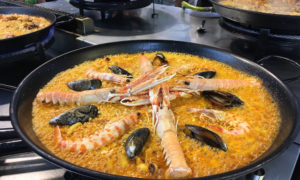
seafood-paella
Paella is a traditional Spanish dish from Valencia. It is a rice dish that can have meat, fish, seafood, and vegetables and is characterized by its use of saffron, which gives it a yellow color and unique flavor. There are three main types of paella:
● Valencian paella
(paella valenciana ): rice, green vegetables, rabbit, chicken, or duck, snails, beans, and seasoning.
● Seafood paella
(paella de mariscos ): rice, seafood, and seasoning.
● Mixed paella
(paella mixta ): combination of seafood, meat, vegetables, beans, and seasoning. Jamón serrano / Jamón ibérico
Jamón
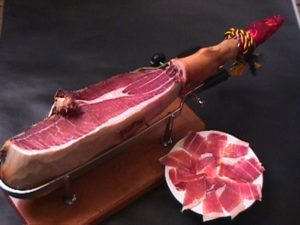
jamon-iberico
Serrano and jamón ibérico are dry-cured Spanish hams that are served in thin slices. Jamón serrano is named after the custom of drying the salted and cured ham in a shed high on a mountain, or sierra . Serrano is the adjective form of sierra. While jamón serrano is typically made from the Landrace white pig, jamón ibérico, which is much more expensive, is made from black Iberian pigs, and often called jamón de pata negra. Despite their differences, both jamones are deliciously salty and savory examples of Spanish cuisine!
Queso manchego
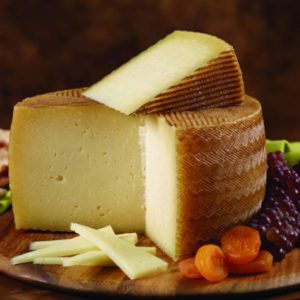
manchego-cheese
Another traditional Spanish food, queso manchego is typically eaten together with jamón serrano or jamón ibérico. Queso manchego is a sheep’s milk cheese from the La Mancha region of Spain. It is firm and buttery and a wonderful complement to many Spanish dishes.
Tapas
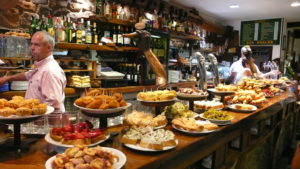
Spain-tapas
Tapas are a great Spanish food tradition consisting of small dishes of different types of food, like appetizers or snacks. The dishes may be cold (jamón serrano, queso manchego, olives, etc.) or warm (tortilla española, meatballs, etc.) and can be served as bar food or a complete meal. Eating tapas is a great opportunity to taste a whole variety of flavors and dishes, so if you are ever in Spain make sure to order tapas and experience what the country has to offer!
Tortilla Española

Tortilla-Espanola
Another great typical Spanish food is tortilla española, an omelette-like potato dish fried in olive oil and served as a tapa. It is a filling and flavorful dish (with the addition of chopped onions) and is often sliced and served both warm and cold.
Flamenco
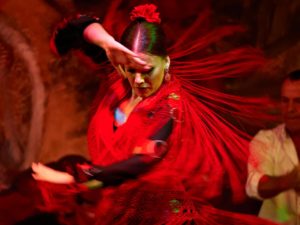
Flamenco-Dancer
Flamenco music reigns as one of the more recognizable traits of Spanish culture. The staccato dancing style and soulful plucking of classical guitars over mournful vocals make for an enchanting spectacle. Gypsies in southern Spain introduced flamenco music to the rest of the country, and many towns and cities in southern Spain still feature rustic flamenco venues with top notch talent. Madrid and other big cities also boast an abundant variety of flamenco shows for tourists to experience.
Bullfights
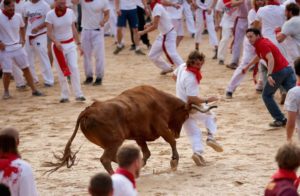
running-of-the-bulls-Pamplona
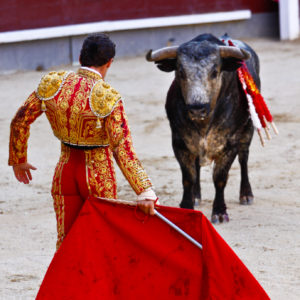
Bullfighting-Spain
Bullfighting is inextricably linked to Spanish culture, no matter how many animal rights groups protest the sport as cruel and immoral. Developed out of the bloody gladiator traditions formerly practiced during the time of the Roman Empire, bullfighting gradually rose to national prominence. The image of a bold matador sweeping his cape past a charging bull is undoubtedly one of the most commonly associated elements of Spanish culture. As evidence of this, many of the biggest bullfighting rings in the world can be found in Spain, with major venues in cities like Madrid, Seville, Valencia and Pamplona.
Transportation in Spain
Spain is one of the largest countries in Europe with some 900 kilometers separating the Northern and Southern coasts, and approx.1000 kilometers from the Mediterranean Sea to the Atlantic Ocean. Travelling in the country requires time to cover such long distances.
Travelling by Car
This is an option I chose to see Spain, since we wanted to maximize our schedule, but our demanding itinerary and distances we needed to cover made it difficult to hire a driver at reasonable rate.
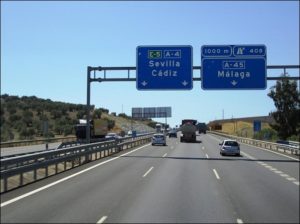
Traveling-by-car-Spain
Travelling by car is highly recommended if you intend to visit different cities. Highways and good roads communicate the center of the country -and thus the capital, Madrid– with the main Spanish cities, however it can be a bit more difficult to reach less popular cities or villages which may not have such good communications.
You may check how to get to your destination and find the best routes in websites such as: www.viamichelin.com or www.guiacampsa.com. My favorite is Google maps, which doubles as a free GPS system. Many different companies offer car rentals. For our trip I used Avis, since it is a rewards partner with SPG, and had some great rates.
Travelling by Train
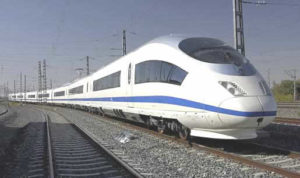
Spanish-Speed-Train

Train-First-Class-Spain
Travelling by train can also be a convenient option, since they are quite comfortable and cheap, but some Spanish trains may not be as fast as you may expect. In fact, the Spanish speed train (AVE) runs only from Catalonia (in the North) to Andalusia (in the South) crossing Madrid, with no other routes available for the moment. Bear in mind that the speed train tickets are significantly more expensive than standard trains. If you choose this option, check prices for both 1st and 2nd class. TRAVEL TIP In many cases, unlike flying, where it comes to train travel in Europe, I find First class to be just slightly more expensive than Second class, and worth an upgrade.
You will find train schedules and tariffs in this website: www.renfe.es Booking online is also possible at the site.
Transportation by Bus

bus-Spain
Buses reach places where trains do not go to, coaches will also offer you better schedules and destinations than trains. There are different bus companies working in Spain depending on the destination. I recommend you the following sites for planning your trip by bus:
www.movelia.es , www.auto-res.net or www.alsa.es
Travelling by Plane

Iberia-Spanish-Airlines
Plane travel is also a good choice, main cities are connected by plane, and it will save you a lot of time if you need to cover long distances. Here are some websites from main airlines offering domestic flights within Spain:
www.air-europa.com or www.iberia.com
Language: Castilian Spanish Dialect
Spanish in Spain is referred to as Castellano.
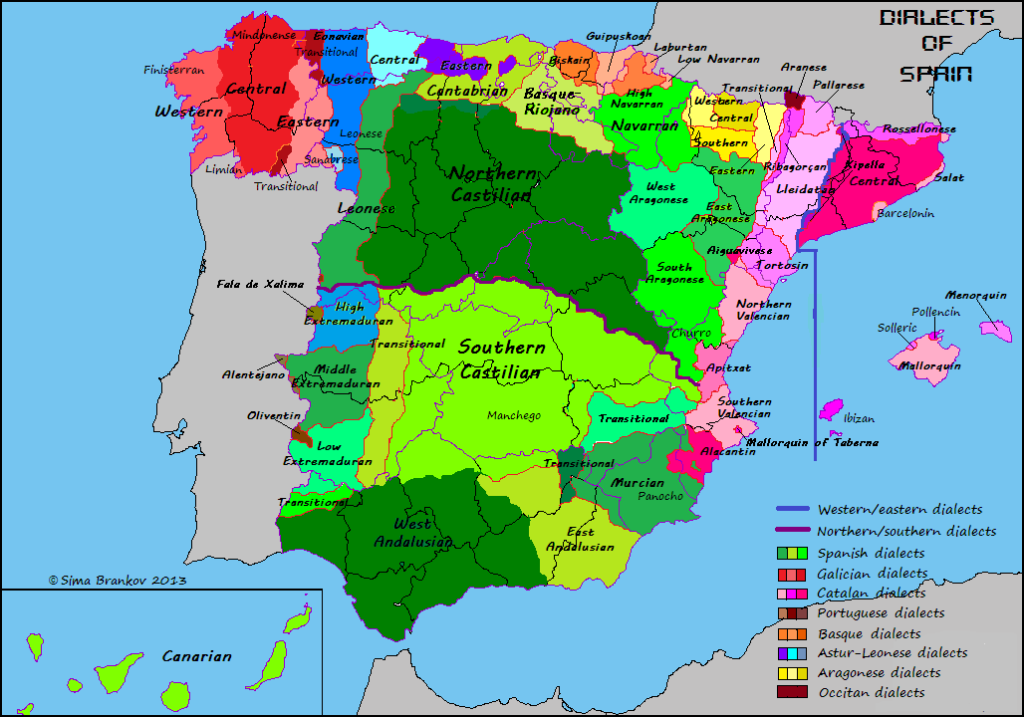
Languages-Spain
History of Spanish language: After the fall of Roman Empire, Vulgar Latin was dominant, then it took on a different form, integrating Arabic and forms of a related dialect called Mozarabic. It is estimated that approximately 3000-4000 words in today’s Spanish are derived from Arabic. Castilian dialects of Spanish started to take form around the 13th century with King Alfonso X, referred to as the Learned-King of Castile and Leon. Toledo became the cultural epicenter for the King and his scholars. In Toledo, these scholars created works in Castilian Spanish and then began a series of translations of the various works of science, law, literature, history, etc. into Castilian Spanish. These translations became the basis for the dissemination of information in a significant part of Western Europe. The King soon declared Castilian as the official language for government documents and decrees. The dominance of the Castilian dialect continued to grow as the Catholic kingdoms took over most regions of Spain. Isabella and Ferdinand declared Castilian Spanish to be the official dialect. Soon thereafter appeared the Art of the Castilian Language, a work that helped shape and standardize the Spanish language. Castilian Spanish then quickly became the official language for all educational materials and official documents in all of Spain. Certain regions maintained different dialects, most notably Andalusian, spoken in and around Seville, and Catalan around Barcelona.
Learn few phrases and words and you will make friends in no time. If I feel ambitious I use pimsleur.com, or if I need a quick lesson or few phrases YouTube.com .
Safety and Security
Crime
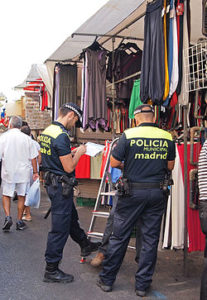
Madrid-Police
Petty crime, such as pickpocketing and purse snatching, is common. It is most prevalent in larger cities and particularly during holidays, festivals and weekends. Thieves are especially active in crowded areas, such as:
● airports
● public transportation facilities
● roads ● hotel lobbies
● restaurants and outdoor cafés
● beaches
● tourist attractions
Violent crime is rare, but it does occur.
Don’t be scared to travel, just be aware of your surroundings at home and abroad. Don’t do stupid things you wouldn’t do at home, and you will be safe and have time of your life!
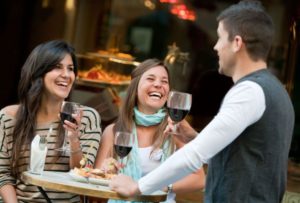
Spain-Make-Friends

Visit-Spanish-Beach
Now that you are armed with basic background on Spain’s History, Food, Culture and Language , let’s explore its great destinations together and have fun!!!

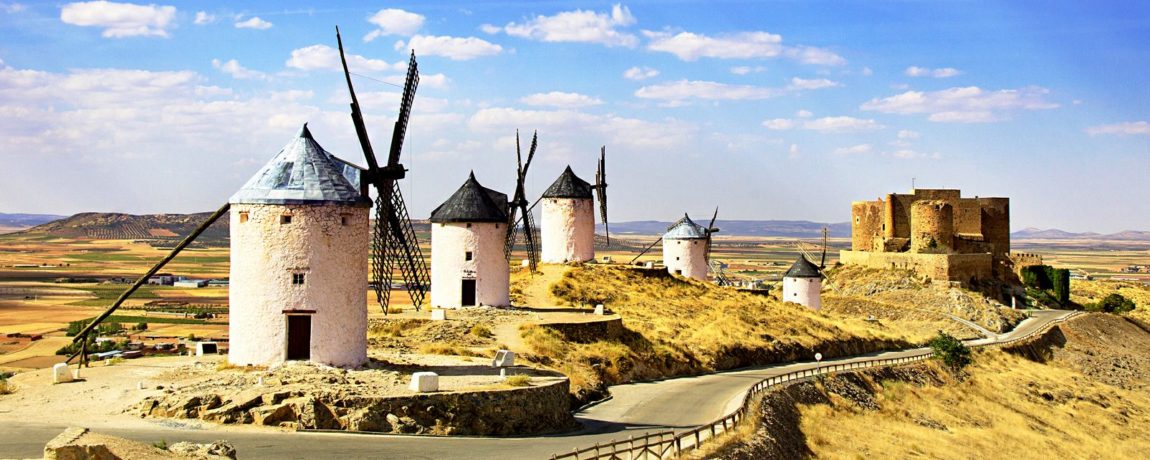

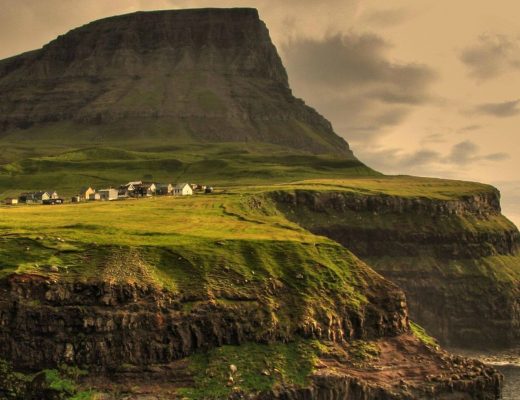
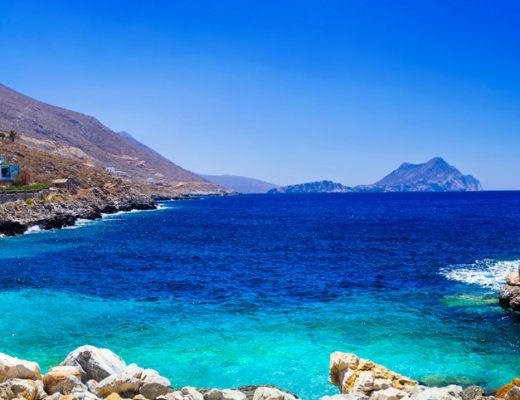
Spanish Wines, Grapes and Wine Regions: Rioja, Cava, Ribera del Duero, Tempranillo and Garnacha - PointsTravels
July 15, 2018 at 6:24 am[…] favorite is Abadia Retuerta “Seleccion Especial”), taste it, share it, enjoy it and have fun traveling through Spain with […]